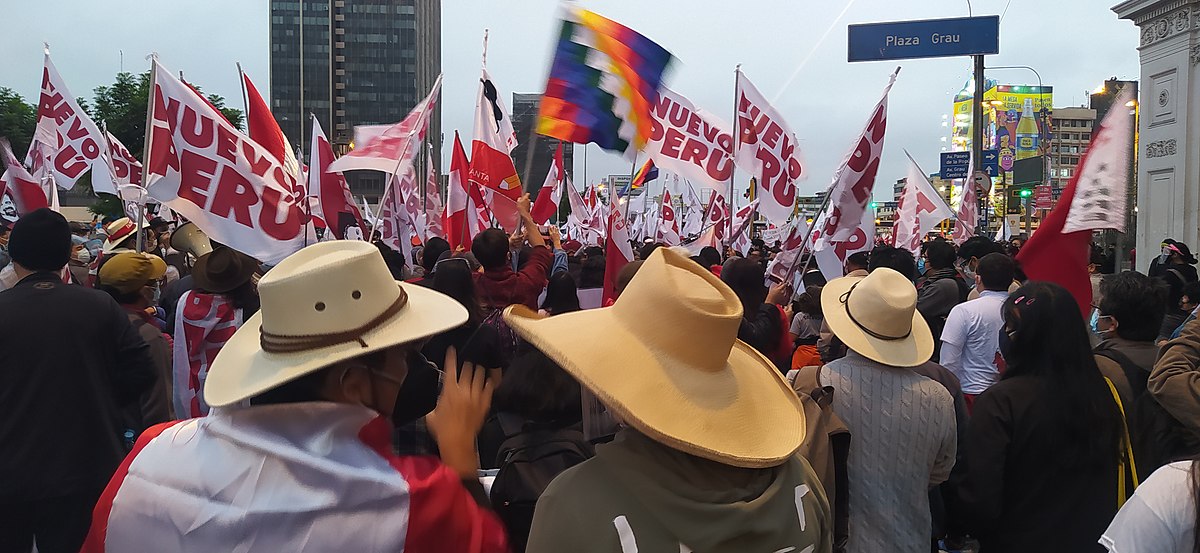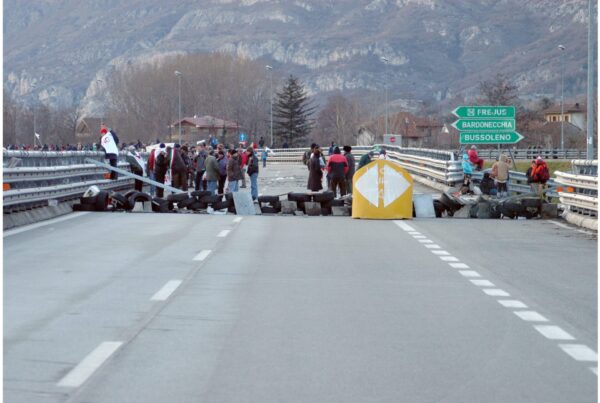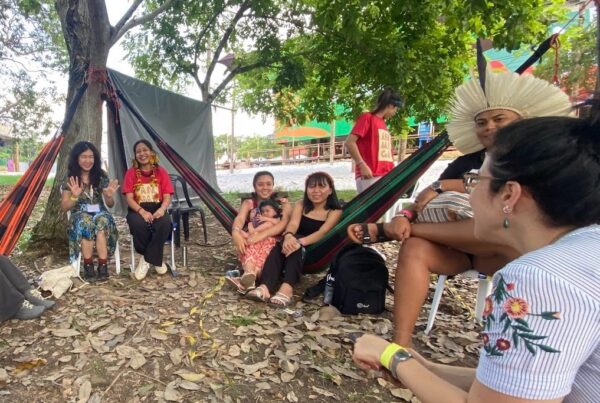By Raquel Neyra
The return of the left in the government of Peru represents the end of the Fujimori era of violence, corruption and racism; at the same time, the tension between the redistribution of mining wealth and the defense of territories against extractivism will be a key challenge for the government, as well as for grassroots movements.
In the last elections, Pedro Castillo, candidate of the leftist Peru Libre party, a rural school teacher, emerged as the winner, championing the oppressed and forgotten populations for centuries. Castillo also managed to rally the vote of citizens fed up with corruption and years of state violence, represented in the elections by the right-wing candidate, Keiko Fujimori, daughter of dictator Alberto Fujimori (1990-2000).
Immediately, the media at the service of the power groups shouted to the skies and claimed a possible “Venezuelanization” of the country. The old bogeyman of terrorism, communist threats and destabilization of the country was unearthed fears to which half of the population succumbed.
Expressions of racism such as “the teacher does not know how to speak or calculate” (“and neither do the cholos and Indians”), were uttered without any shame and without any basis. The fracture that the country is experiencing today is not new, and has its origin in the colonial history of the invasion of the territory, the extraction of raw materials and the construction of racism that sustains this extraction. The white Creoles continued the colonial policies, sometimes as savagely as the Spanish invaders.
“Peru, a mining country”, has been repeated by different governments as a dogma to justify extractivism, alluding to mining extraction in pre-Inca and Inca times. Starting in the 1970s, the different governments saw mining as the source of income that would boost GDP growth and lift the country out of poverty. Today, minerals represent 60% of exports and their volume of extraction has quadrupled in just 40 years.
The internal war of the 1980s slowed extraction and pushed thousands of people to migrate to Lima, the country’s capital. This marginalized population, never integrated by the government and relegated to being the cheap and informal jobs of the capital’s booming sector, constituted a strong voting base for Castillo in these elections.
Neoliberalism and extractivism
In 1990, Alberto Fujimori was elected, amidst great expectations because of his different appearance from previous presidents and his promises to pacify the country. With his government’s cycle of privatization of “unprofitable” state-owned mining companies, he resorted to a massive layoff of workers, which weakened the unions. It is important to note this point since, later on, the main actors of the resistance were not the unions, but the forces regrouped around the agricultural population, and the peasant and indigenous organizations.
In order to contain the high level of social protest, Fujimori implemented a social assistance and infrastructure construction plan that contributed to his acceptance by the impoverished popular masses, at the same time that he set himself up as the savior of the country, having supposedly defeated the Shining Path guerrillas and captured their leader Abimael Guzmán.
The leftist parties at the time were strongly fragmented (at one point there were more than 20 leftist parties and nuances), often following international political divisions. Fujimori introduced a new Constitution and applied a series of legal measures that transformed the national territory by authorizing free prospecting of the territory, concessions on natural resources (from 0-6% concessions in 1992 to 72-100% in 2011 according to Oxfam’s 2014 report) and weakened community land tenure; in 2016 the Common Good Institute estimated that almost 50% of peasant communal land is under concession to extractive companies.
It is the change to this Constitution that the population demanded during the protests of November 2020. The tax stability contracts that Fujimori introduced in the mining sector, guaranteeing that there would be no variation in taxation conditions for 10-15 years—very favorable for transnational companies—are today questioned by leftist sectors. Indeed, according to Pedro Francke, a World Bank advisor and Pedro Castillo’s current economic spokesman, it is necessary to revise these contracts so that the communities and populations around the mining centers benefit from the higher taxation. The objective would be to promote “development” through a “frank dialogue” between communities and mining companies.
This distributionist discourse has influenced some populations around mining centers, believing that money will solve everything. The lack of public health and educational infrastructures reinforces this claim. A voluntary absence of the state whose objective is to let corporations act.
As early as October 2007, former President Alan Garcia (2006-2011) publicly dared to describe the indigenous population that opposed oil exploitation on their lands as “second class”, arguing that they represented an obstacle to the country’s “progress”. In this way, he justified the violence against this population during the ‘Baguazo’ in 2009: thousands of Amazonian indigenous people had blocked the road in the district of Bagua protesting against a hundred harmful decrees and laws that favored private investment in their territories. The government sent in the armed forces and police, who plunged the resistance into a bloodbath.
Successive governments applied the same extractivist policies endorsed by ad hoc laws such as the “paquetazos ambientales” (a mega-package of anti-environmental reforms) of former President Ollanta Humala (2011-2016). These measures attempted to “reactivate the economy” through environmental deregulation and criminalization of protest. National and international human rights organizations, such as the Inter-American Commission on Human Rights, expressed their concern.
Although former President Humala’s redistributive policies reduced monetary poverty from 57.7% to 22.7%, socio-environmental conflicts continued to intensify, with 180-230 conflicts each month, according to data from the Ombudsman’s Office (Defensoría del Pueblo), which has been recording social conflicts since 2004. These socio-environmental conflicts represent 60-70% of all conflicts in the country, and since 2004, more than 105 environmental defenders have been killed. Contamination has become a widespread problem: a study by the General Directorate of Health in 2020 indicates that 30% of the population is at risk of exposure to heavy metals, 20% to metalloids such as arsenic and 6% to hydrocarbons; these are mind-boggling figures.
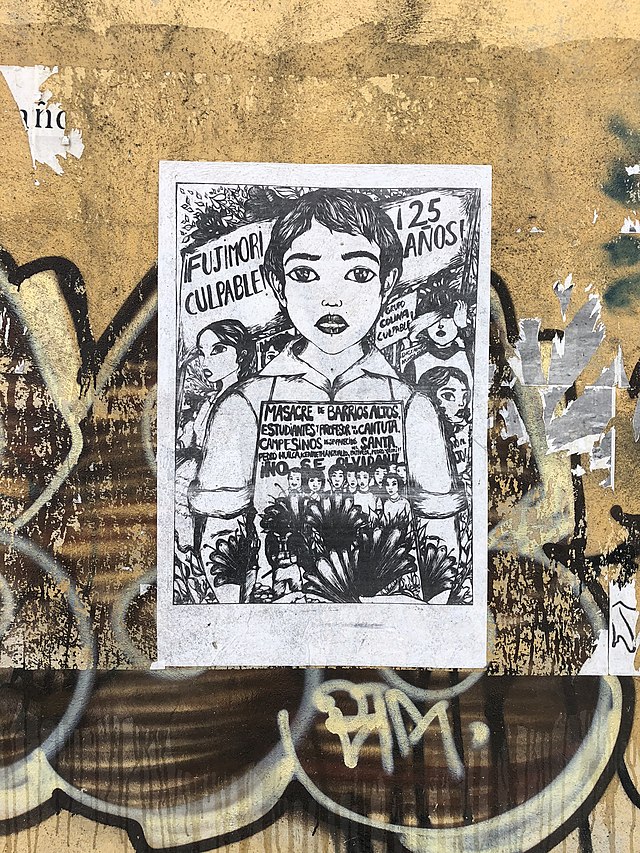
Poster denouncing the crimes of Alberto Fujimori, November 2018. Source: Wikimedia Commons.
Popular environmentalism
Parallel to this extractivist expansion there has been a history of spontaneous, localized resistance struggles, examples of popular environmentalism, as indicated by the high rate of participation of indigenous peoples and peasants (in 98% of cases) in such struggles, such as in Espinar, Tambogrande, or Conga.
The attempts at institutionalization by former President Velasco in the 1970s did not help the consolidation of the movement; on the contrary, it reduced its autonomy. The destruction by Sendero Luminoso and the Fujimori government of any attempt at organization that was not favorable to them, ended up stalling any possible articulation at the national level. In 1999, the National Confederation of Peruvian Communities Affected by Mining (CONACAMI) was formed in response to the expansion of mining activities, but it was unable to maintain a national presence. It is this dispossession and discrimination that the subjugated population hopes to reverse with Castillo.
Ecology is not present in the party branch. The presence of the Green Alternative Party is almost nil. The movement that awakened political fervour in its time and for some years was Tierra y Libertad, born in 2009 from the resistance struggles against mining in Cajamarca, but nevertheless, the hegemonism of one of its founders has been diminishing its existence.
In the 2016 presidential elections, the leftist Frente Amplio was formed, with Verónika Mendoza as its candidate. The Frente Amplio won 20 seats in Congress (thanks to the fact that the leading political party was disqualified shortly before the elections). Its electorate is, still today, mainly located in the south. But the Frente Amplio split in 2017 due to internal struggles, Mendoza withdrew and founded the grouping Nuevo Perú, of progressive-left hierarchical cut.
Right-wing disagreement and the pandemic
In recent years, corruption scandals have multiplied. First came the Lava Jato case (Operation Car Wash), a corruption scheme uncovered in Brazil, associated with the construction company Odebrecht, which in Peru involved political parties. Then came cases such as judicial gang dubbed “The White Collars of the Harbor“, the “Construction Club”, the Interoceanic Highway, the Chinchero airport, and a long etcetera where former presidents, businessmen and high-ranking officials are implicated.
After all, Peru holds the record of being the only country in the world with five successive presidents sentenced for corruption; former President Alan Garcia committed suicide in April 2019 when his arrest was imminent. According to Transparency International, Peru is one of the countries in Latin America where the perception of corruption is highest.
The pandemic left millions of people unemployed, without access to bonuses, indigenous peoples abandoned to their fate, health in a catastrophic state (new record: #1 country in the world in deaths per inhabitant), the press denounced swindles and favouritism at government level, students and schoolchildren in the provinces could not return to class because of lack of internet connections; thousands of rapes, disappearances and femicides were denounced, thousands of girls became mothers. Women were once again victims of double oppression. There was no light at the exit of the tunnel, the long tunnel.
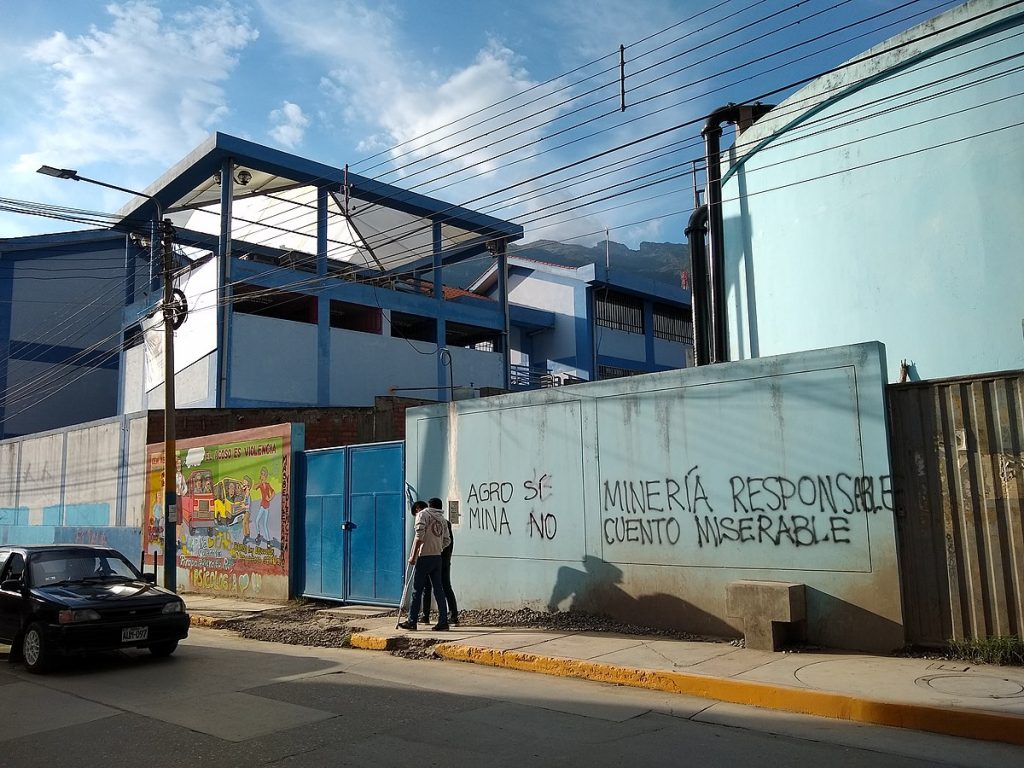
“Yes to agro, no to mining.” “Responsible mining, miserable lie”. Graffiti in Abacay, Peru. Source: Wikimedia Commons.
And the teacher arrived
Peru Libre was founded in 2008, at the initiative of Vladimir Cerrón, twice regional governor of Junín, who was denounced for corruption by the public prosecutor’s office, which disqualified him from holding public office. His party welcomed the teacher Pedro Castillo, a well-known leader of the teachers’ strike of 2017, as its candidate in the 2021 elections.
During the presidential campaign, Castillo fell into many gaps and contradictions, perhaps because of the increasingly accentuated distance he wants to put between him and Cerrón at a programmatic level. Finally, he surrounded himself with advisors from New Peru, which assured him of their support. In him, the so-called “deep Peru” was recognized: the peasants, the forgotten, the subjugated indigenous, the impoverished populations of the city of Lima — although the Amazonian indigenous organizations had to make him see that they also existed.
But, like New Peru and the other leftist groupings in the country, Castillo continues to promote extractivism, with a model of redistribution of economic benefits, according to his slogan “No more poor people in a rich country.” In his electoral campaign the issue of nationalization of mining was central, although after the elections this discourse was put aside to calm the markets. There is no talk of ecology or defense of the territories and populations affected by extractivism. Castillo has even labelled environmental defenders as “fundamentalists”.
At most, it promotes “clean mining”, respectful of international standards, just as former President Humala did, without saying what those international standards are and without anyone knowing what “clean mining” means. Its economic spokesman considers that a mining project should not go when there is “too much” contamination and manifest opposition. But what is too little or too much contamination? Lead in the blood? Or does it refer to the extent of contaminated land?
What awaits us
We are on the threshold of a possible change. Will Castillo’s government be a government similar to that of Correa or Morales, which reinforces extractive capitalism with redistribution of income, with the support of sectors of the popular classes, and seeks to take power away from the popular environmental movements? We start with a disadvantage, because we do not have a national environmental organization that can respond in unison, but a series of diverse and geographically dispersed social organizations. Or will your government know how to listen to the social movements that have voted for it, when they complain about the damage to health and environment, about the grabbing of their lands, about the extractive projects?
It is evident and indisputable that Castillo represents the necessary end of the Fujimori era, synonymous with violence, corruption, drug trafficking, racism. But, how strong and united can his government be in a liberal parliamentary system that has all the weapons to resign him, with a majority in Congress with a pro-Fujimori style? Castillo will have to rely on the masses that elected him, on all of them, on alliances, on the subjugated people in search of recognition; and integrate the defense of the environment, if he wants to last.
—
Raquel Neyra is a Peruvian researcher and activist. She is a professor of the Natural Resources and Sustainable Development at La Molina Agrarian University, Peru, advisor to civil institutions in Cajamarca in environmental defense, and a member of the Political Ecologies/Abya Yala working group of the Latin American Council for the Social Sciences (CLACSO). She is the author of the book Socio-environmental conflicts in Peru. Violencia y extractivismo (Editorial Abya Yala), and several articles and book chapters on the subject of environmental justice.
Featured image: Mobilization in Lima, Peru during the June 2021 elections. Source: Wikimedia Commons.


